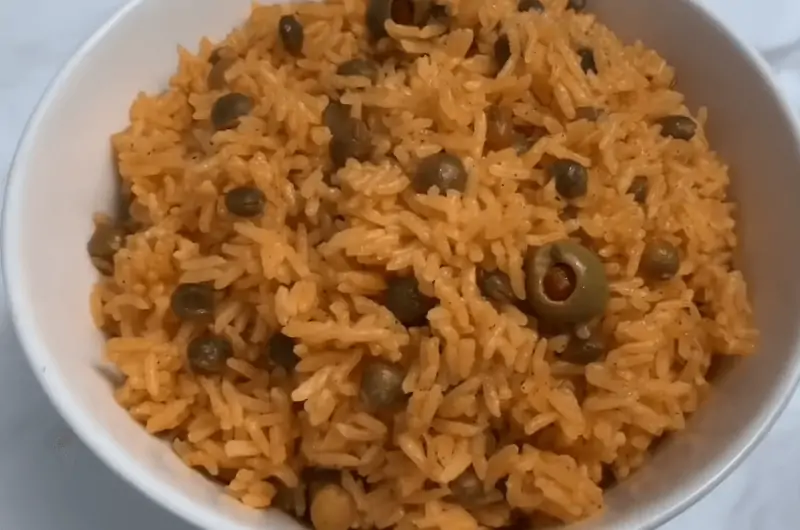The Best Fluffy Pancakes recipe you will fall in love with. Full of tips and tricks to help you make the best pancakes.
When it comes to flavorful and comforting dishes, one that often stands out is the beloved “Moro de Guandules.” This traditional Dominican dish has captured the hearts and taste buds of many with its rich history and unforgettable taste. In this article, we’ll delve into the origins of moro de guandules, the ingredients that make it unique, the cooking process that transforms it into a culinary masterpiece, and the joy it brings to those who savor it.
Exploring the Delightful Dish: Moro de Guandules

Table of Contents
What is Moro de Guandules?
Moro de Guandules is a traditional Dominican dish that combines rice and pigeon peas in a symphony of flavors. The term “Moro” refers to the rice and pigeon peas mixture, while “Guandules” refers to the pigeon peas themselves. The dish is known for its aromatic blend of spices, including dried oregano and paprika, which infuse the rice with a tantalizing aroma and a burst of taste.
Beyond its culinary appeal, Moro de Guandules holds a deeper meaning that is intertwined with Dominican culture and history. The dish is a reflection of the island’s diverse heritage, blending indigenous, African, and European influences into a harmonious union of flavors. The word “moro” itself is believed to have African roots, referring to a rice and pea dish that has been adapted and enriched over time.
Origins
Moro de Guandules, the cherished Dominican dish, has a captivating history that spans centuries. This delectable blend of rice and pigeon peas showcases the evolution of Dominican culinary traditions, fusing indigenous, Spanish, and African influences into a harmonious whole. Let’s explore a chronological journey through the origins of Moro de Guandules, tracing its path from its humble beginnings to its esteemed status in contemporary Dominican cuisine.
- The Indigenous Roots: The story of Moro de Guandules begins with the indigenous Taino people, who inhabited the Dominican Republic long before the arrival of European settlers. The Taino people cultivated pigeon peas, known as “guandules” in Spanish, as a staple crop. These small, round legumes were not only a source of sustenance but also an essential part of Taino culture and cuisine.
- Spanish Influence: With the arrival of Spanish explorers and colonizers, a culinary fusion began to take shape. The Spaniards introduced rice to the Dominican Republic, which blended seamlessly with the existing guandules cultivated by the Taino people. This amalgamation of ingredients and techniques laid the foundation for what would eventually become Moro de Guandules.
- African Influence and the Rise of Moro: During the transatlantic slave trade, African culinary traditions further enriched the Dominican gastronomic landscape. Enslaved Africans brought with them their expertise in using spices, herbs, and cooking methods that added depth and complexity to local dishes. As rice and guandules continued to be staple ingredients, the dish we now know as Moro de Guandules began to take shape.
- Evolution: Over the centuries, Moro de Guandules continued to evolve, adapting to the changing cultural and culinary landscape. While the basic components remained consistent—rice, guandules, and aromatic spices—variations emerged based on available ingredients and regional preferences. Families passed down their unique recipes, resulting in a rich tapestry of flavors that represent different households and communities.
- Symbolism and Cultural Significance: Beyond its delicious taste, Moro de Guandules carries deep cultural significance within Dominican society. This dish is often prepared for special occasions, family gatherings, and celebratory events. Its presence on the dining table signifies unity, tradition, and shared experiences. Moro de Guandules not only sustains the body but also nourishes the spirit by connecting individuals to their heritage.
- Contemporary Resonance: In today’s culinary landscape, Moro de Guandules remains a beloved dish that embodies the essence of the Dominican Republic. While recipes may vary, the core ingredients and the spirit of culinary fusion persist. Chefs and home cooks alike continue to experiment with different spices, herbs, and cooking techniques, infusing new life into this timeless classic.
- Preserving Tradition and Embracing Innovation: As globalization and modernization influence Dominican cuisine, there’s a delicate balance between preserving tradition and embracing innovation. Moro de Guandules stands as a testament to this balance, honoring its historical roots while welcoming new interpretations and creative twists.
The captivating journey of Moro de Guandules from its indigenous beginnings to its place in modern Dominican culture reflects the resilience, adaptability, and creativity of the nation’s people. This dish’s evolution mirrors the broader narrative of the Dominican Republic—a harmonious blend of diverse influences that come together to create something truly exceptional. As we savor each bite of Moro de Guandules, we not only taste the flavors of the past but also celebrate the vibrant and ever-evolving culinary heritage of the Dominican Republic.
Popularity of Moro De Guandules
Moro de Guandules, a beloved Dominican dish, has transcended borders to capture the hearts—and taste buds—of food enthusiasts worldwide. This delightful combination of rice and pigeon peas, infused with aromatic spices, has gained international recognition and popularity. Let’s explore the countries where Moro de Guandules has become a celebrated culinary gem.
- The Dominican Republic: At its heart, Moro de Guandules is an integral part of Dominican cuisine. In its homeland, this dish is more than just food; it’s a cultural symbol that reflects the nation’s rich history and diverse influences. From family gatherings to festive celebrations, Moro de Guandules is a staple on Dominican dining tables, where its flavors evoke a sense of tradition and togetherness.
- Puerto Rico: Across the waters in Puerto Rico, Moro de Guandules has found a second home. This variation, known as “Arroz con Gandules,” pays homage to the dish’s Dominican origins while adding its own unique flair. The Puerto Rican version often includes ingredients like sofrito—a blend of herbs and aromatics—and adobo seasoning, creating a distinctive and mouthwatering experience.
- Cuba: In Cuba, Moro de Guandules takes on a new identity, known as “Arroz con Guandules.” This Cuban rendition showcases the fusion of flavors that define the Caribbean region. The dish combines guandules, rice, and a medley of spices to create a comforting and satisfying meal that resonates with both locals and visitors.
- Panama: Panama, with its diverse cultural influences, has embraced Moro de Guandules as part of its culinary tapestry. Here, the dish often incorporates local ingredients and spices, resulting in a version that pays homage to tradition while offering a unique Panamanian twist. Moro de Guandules has seamlessly integrated itself into Panamanian culture, becoming a favorite at gatherings and celebrations.
- United States: In cities with vibrant Caribbean communities, such as New York and Miami, Moro de Guandules has gained a devoted following. Caribbean restaurants and eateries serve up this flavorful dish as a nostalgic taste of home for many immigrants and a delicious discovery for adventurous eaters. The dish’s presence in these multicultural hubs showcases its ability to bring people together through food.
Moro de Guandules, with its irresistible blend of textures and flavors, has transcended its Dominican origins to become a beloved dish in countries around the world. Whether it’s enjoyed in the heart of the Dominican Republic, reimagined in Puerto Rico and Cuba, or embraced with unique interpretations in Panama and beyond, this culinary gem continues to unite people through the universal language of food. As we savor each mouthful of Moro de Guandules, we celebrate not only its deliciousness but also the cultural connections it fosters across borders.
Variations of Moro de Guandules
Moro de Guandules, the beloved Dominican dish, serves as a canvas for culinary creativity that extends beyond its traditional roots. While the classic version remains a cherished favorite, innovative cooks across cultures have put their unique spin on this flavorful combination of rice and pigeon peas. Here are some variations of Moro de Guandules that showcase the versatility of this culinary gem.
- Classic Moro de Guandules: The classic Moro de Guandules recipe is a testament to the harmonious blend of rice, pigeon peas, and aromatic spices. This version, deeply rooted in Dominican culture, pays homage to the dish’s origins and captures the essence of tradition. Its comforting flavors and familiar aromas evoke a sense of nostalgia and warmth.
- Arroz con Gandules: In Puerto Rico, the dish takes on the name “Arroz con Gandules,” reflecting the island’s unique culinary influences. This variation introduces ingredients like sofrito—a mixture of herbs, onions, and peppers—and adobo seasoning, infusing the dish with layers of vibrant flavors. The result is a Puerto Rican twist that pays homage to its Dominican counterpart while adding its own signature flair.
- Arroz con Guandules: Cuba’s version, “Arroz con Guandules,” mirrors the Caribbean island’s rich cultural tapestry. This variation incorporates pigeon peas, rice, and spices to create a symphony of flavors that embodies the vibrant essence of Cuban cuisine. With every bite, the dish speaks to the fusion of influences that have shaped the island’s culinary identity.
- Moro de Guandules Panameño: In Panama, Moro de Guandules has taken on a distinct Panamanian character. The Panamanian version, known simply as “Moro de Guandules,” showcases the country’s unique spices and ingredients. With a touch of local culinary creativity, this variation captures the essence of Panamanian flavors while honoring the dish’s traditional roots.
- Moro de Guandules Abroad: Beyond the Caribbean, Moro de Guandules has found a home in various international kitchens. Chefs and home cooks around the world have embraced this dish, infusing it with ingredients and techniques that reflect their own culinary traditions. From adding vegetables to introducing exotic spices, these global interpretations highlight the dish’s adaptability and versatility.
- Vegan and Vegetarian Variations: For those seeking plant-based options, Moro de Guandules lends itself beautifully to vegan and vegetarian adaptations. By substituting animal-based ingredients with plant-based alternatives, such as vegetable broth and plant-based proteins, cooks can create dishes that cater to diverse dietary preferences while still capturing the essence of the original flavors.
- Sweet and Savory Combinations: Innovative chefs have taken Moro de Guandules beyond its traditional savory form. By adding ingredients like sweet plantains or coconut milk, they have created delectable sweet and savory combinations that push the boundaries of flavor. These creative twists invite adventurous eaters to explore the limitless possibilities of this versatile dish.
Moro de Guandules, with its foundational blend of rice, pigeon peas, and spices, serves as a canvas for culinary innovation and imagination. From the classic recipe that honors tradition to international adaptations that celebrate global influences, this dish’s variations embody the spirit of diversity and creativity in the world of gastronomy. Whether enjoyed in its classic form or reimagined with a twist, Moro de Guandules continues to bring people together through its rich flavors and the joy of culinary exploration.
Is Moro De Guandules un-healthy?
Moro de Guandules, a beloved Dominican culinary masterpiece, isn’t just a feast for the taste buds—it also brings a wealth of health benefits to the table. Packed with a medley of nutrient-rich ingredients, this delightful dish offers a balanced combination of flavors and nourishment. Let’s uncover the numerous health benefits that Moro de Guandules brings to your plate.
- Plant-Based Protein Powerhouse: Pigeon peas, the star ingredient of Moro de Guandules, are a nutritional powerhouse when it comes to plant-based protein. These legumes provide an excellent source of protein for those following a vegetarian or vegan diet, supporting muscle growth, repair, and overall bodily functions. Including Moro de Guandules in your diet can help meet your protein needs while enjoying a flavorful meal.
- Dietary Fiber for Digestive Health: The combination of pigeon peas and rice in Moro de Guandules brings a hearty dose of dietary fiber to your diet. Fiber plays a crucial role in promoting healthy digestion by aiding in regular bowel movements and preventing constipation. Additionally, fiber helps maintain a feeling of fullness, supporting weight management and overall gut health.
- Nutrient-Rich Spices and Herbs: The aromatic spices and herbs used in Moro de Guandules are more than just flavor enhancers—they also contribute to its nutritional profile. Ingredients like garlic, onions, and culantro leaves contain antioxidants that combat oxidative stress and inflammation in the body. These antioxidants play a role in promoting overall well-being and reducing the risk of chronic diseases.
- Complex Carbohydrates for Sustained Energy: The rice component of Moro de Guandules provides complex carbohydrates, offering a steady source of energy for your daily activities. Unlike simple sugars that lead to rapid energy spikes and crashes, complex carbohydrates release energy gradually, helping you maintain consistent energy levels throughout the day.
- A Low-Glycemic Index Choice: For those conscious of their blood sugar levels, Moro de Guandules is an excellent option due to its low glycemic index (GI). The combination of fiber, protein, and complex carbohydrates in this dish helps stabilize blood sugar levels, making it a suitable choice for individuals with diabetes or those looking to manage their sugar intake.
- Heart-Healthy Components: Moro de Guandules contains ingredients that contribute to heart health. Olive oil, often used in the sautéing process, is a source of heart-healthy monounsaturated fats. Additionally, the dish’s fiber content helps lower cholesterol levels, reducing the risk of heart disease and supporting cardiovascular well-being.
- Immune-Boosting Potential: The combination of nutrient-rich ingredients, such as spices and herbs, lends Moro de Guandules immune-boosting potential. The antioxidants present in these ingredients help strengthen the immune system and protect the body from infections and illnesses.
Moro de Guandules is not only a culinary delight but also a nutritional treasure trove. From its plant-based protein and dietary fiber to its antioxidants and heart-healthy components, this dish offers a holistic approach to well-being. By incorporating Moro de Guandules into your diet, you’re not only treating your taste buds to a flavorful experience but also nourishing your body with a variety of essential nutrients.
How to Make Moro De Guandules
Moro de Guandules, the cherished Dominican dish, is a culinary masterpiece that marries the richness of rice and pigeon peas with a symphony of aromatic spices. If you’re eager to embark on a flavorful journey and create this delightful dish in your own kitchen, we’ve got you covered. In this step-by-step guide, we’ll walk you through the process of making Moro de Guandules from start to finish.
Ingredients You’ll Need
Before you begin, gather the following ingredients:
- Long-grain rice
- Pigeon peas (canned or soaked dried peas)
- Coconut milk
- Red bell pepper
- Onion
- Garlic
- Dried oregano
- Paprika
- Chicken or vegetable broth
- Olive oil
- Salt and pepper to taste
- Fresh culantro leaves
Step by Step Cooking Guide
Step 1: Sauté the Aromatics
- Heat 2 tablespoons of olive oil in a large pot over medium heat.
- Add the chopped onions and diced red bell pepper. Sauté until the onions become translucent and the bell pepper softens.
Step 2: Add the Rice and Spices
- Add 1 cup of long-grain rice to the pot. Stir the rice to coat it with the sautéed aromatics.
- Sprinkle in 1 teaspoon of dried oregano and 1 teaspoon of paprika. Stir to evenly distribute the spices.
Step 3: Introduce the Coconut Milk
- Pour in 1 cup of coconut milk, infusing the dish with its rich and creamy essence.
Step 4: Incorporate the Pigeon Peas
- Add 1 cup of pigeon peas (either canned or soaked dried peas) to the pot. The pigeon peas will contribute their earthy flavor to the dish.
Step 5: Simmer and Cook
- Pour in 2 cups of chicken or vegetable broth to the pot, ensuring that the rice and peas are submerged in liquid.
- Season with salt and pepper to taste. Stir the mixture to combine all the ingredients.
Step 6: Cook Until Tender
- Bring the mixture to a boil, then reduce the heat to low.
- Cover the pot with a tight-fitting lid and let the dish simmer for about 20-25 minutes, or until the rice is tender and has absorbed the flavors.
Step 7: Garnish and Serve
- Once the rice is cooked, remove the pot from the heat.
- Let the dish sit, covered, for a few minutes to allow the flavors to meld.
- Just before serving, sprinkle fresh culantro leaves over the dish for an added burst of flavor and a touch of vibrant green.
Step 8: Enjoy!
- Serve the Moro de Guandules as a flavorful and hearty main dish.
- Pair it with grilled meat, fried plantains, or a simple avocado salad to create a balanced and satisfying meal.
Congratulations! You’ve successfully created a delicious batch of Moro de Guandules, a dish that embodies the essence of Dominican culinary traditions. The slow infusion of flavors, the blend of textures, and the medley of aromatic spices make this dish a true delight for the senses. Whether you’re cooking for loved ones or indulging in a solo gastronomic adventure, Moro de Guandules invites you to savor every mouthful and celebrate the art of creating a cherished culinary masterpiece in your own kitchen.
Recipe
Moro de Guandules Dominicano
Course: MainCuisine: DominicanDifficulty: Easy4
servings14
minutes30
minutes300
kcal45
gm6
gm10
gm4
gmIngredients
1 cup long-grain rice
1 cup pigeon peas (canned or soaked dried peas)
1 cup coconut milk
1 red bell pepper, diced
1 onion, finely chopped
3 cloves garlic, minced
1 teaspoon dried oregano
1 teaspoon paprika
2 cups chicken or vegetable broth
2 tablespoons olive oil
Salt and pepper to taste
Fresh culantro leaves for garnish
Directions
- Heat 2 tablespoons of olive oil in a large pot over medium heat. Add the chopped onions and diced red bell pepper. Sauté until the onions become translucent and the bell pepper softens.
- Add 1 cup of long-grain rice to the pot. Stir the rice to coat it with the sautéed aromatics. Sprinkle in 1 teaspoon of dried oregano and 1 teaspoon of paprika. Stir to evenly distribute the spices.
- Pour in 1 cup of coconut milk, infusing the dish with its rich and creamy essence.
- Add 1 cup of pigeon peas (either canned or soaked dried peas) to the pot. The pigeon peas will contribute their earthy flavor to the dish.
- Pour in 2 cups of chicken or vegetable broth to the pot, ensuring that the rice and peas are submerged in liquid. Season with salt and pepper to taste. Stir the mixture to combine all the ingredients.
- Bring the mixture to a boil, then reduce the heat to low. Cover the pot with a tight-fitting lid and let the dish simmer for about 20-25 minutes, or until the rice is tender and has absorbed the flavors.
- Once the rice is cooked, remove the pot from the heat. Let the dish sit, covered, for a few minutes to allow the flavors to meld. Just before serving, sprinkle fresh culantro leaves over the dish for an added burst of flavor and a touch of vibrant green.
Notes
- To enhance the dish’s flavor, use homemade chicken or vegetable broth instead of store-bought options.
- For an extra layer of complexity, add a pinch of saffron threads to the rice while cooking.
- If you prefer a spicier dish, add a finely chopped scotch bonnet pepper or a dash of hot sauce.
How to Present
Moro de Guandules, a culinary delight from the Dominican Republic, not only tantalizes the taste buds but also offers an opportunity for creative presentation. Elevate your dining experience by learning how to present Moro de Guandules with flair and artful touches. In this section, we’ll share tips and techniques to help you transform this flavorful dish into a visual masterpiece that’s sure to impress your guests.
- Choose the Right Plate: Selecting the appropriate plate for your Moro de Guandules is the first step in creating an appealing presentation. Opt for a plate that complements the colors and textures of the dish. A clean and neutral-colored plate, such as white or light beige, provides an ideal backdrop to showcase the vibrant colors of the ingredients.
- Create an Inviting Base: Start by placing a generous serving of Moro de Guandules at the center of the plate. Use a spoon to gently mound the rice and pigeon peas mixture, creating an inviting base for your presentation.
- Symmetry and Balance: Achieve visual harmony by arranging the components of the dish with symmetry and balance in mind. For example, position the rice and pigeon peas evenly on the plate, ensuring that the dish appears well-proportioned.
- Add Decorative Touches: Enhance the presentation by adding decorative touches to the plate. Consider placing a thin slice of red bell pepper or a sprig of culantro leaves on top of the Moro de Guandules. These small accents contribute to the overall aesthetic and hint at the flavors within the dish.
- Play with Height: Create visual interest by adding height to your presentation. You can achieve this by carefully stacking a small mound of Moro de Guandules in the center of the plate. The vertical element adds dimension and elegance to the dish.
- Garnish with Fresh Herbs: Fresh herbs not only add a burst of flavor but also serve as beautiful garnishes. Sprinkle freshly chopped culantro leaves over the Moro de Guandules for a pop of color and a touch of vibrancy. The contrasting green against the warm tones of the dish creates an eye-catching visual effect.
- Consider Color Contrast: When presenting Moro de Guandules, consider color contrast to make the dish stand out. Place the rice and pigeon peas against a backdrop of colorful vegetables, such as slices of ripe avocado or roasted red peppers. The juxtaposition of hues enhances the visual appeal.
- Embrace Minimalism: Sometimes, less is more. Embrace the beauty of minimalism by allowing the Moro de Guandules to take center stage. A simple arrangement with a focus on the dish’s textures and colors can create a visually striking presentation.
- Capture the Moment: Before indulging in the delicious flavors, capture the presentation by taking a photograph. Share your culinary creation on social media or with friends, and let the artful presentation shine.
Presenting Moro de Guandules with flair is an opportunity to showcase not only your culinary skills but also your creativity. By paying attention to plate selection, symmetry, garnishes, and color contrast, you can transform this beloved Dominican dish into a work of art. Whether you’re hosting a dinner party or simply treating yourself to a special meal, artful presentation adds an extra layer of enjoyment to your Moro de Guandules experience.
How to Eat
Moro de Guandules, with its harmonious blend of rice, pigeon peas, and aromatic spices, is a culinary delight that invites you to savor each bite. Whether you’re enjoying this dish in the comfort of your home or at a restaurant, there are certain techniques and etiquettes to enhance your dining experience. In this section, we’ll walk you through the art of eating Moro de Guandules and how to fully appreciate its rich flavors and textures.
- Start with the Eyes: Before taking your first bite, take a moment to appreciate the presentation of Moro de Guandules on the plate. Observe the colors, textures, and arrangement of the dish—it’s a visual feast that sets the stage for your culinary journey.
- Mix and Blend: Using your fork or spoon, gently mix the rice and pigeon peas to evenly distribute the flavors. This step ensures that every spoonful contains a combination of spices, aromatics, and ingredients, creating a well-rounded taste experience.
- Savor the Aromas: Bring the forkful of Moro de Guandules close to your nose and inhale deeply. The aromatic spices, herbs, and ingredients release a medley of scents that provide a preview of the flavors you’re about to enjoy.
- Take Small Bites: When you take your first bite, focus on taking small and deliberate spoonfuls. This allows you to fully savor the complex flavors without overwhelming your taste buds. As you chew, notice the layers of taste that unfold.
- Explore the Textures: Pay attention to the textures within Moro de Guandules. Notice the tender rice grains, the slightly firm pigeon peas, and any additional ingredients that add crunch or creaminess. The interplay of textures contributes to the dish’s overall appeal.
- Chew Slowly and Mindfully: Chew each bite slowly and mindfully, allowing the flavors to mingle on your palate. This deliberate approach to eating enhances your connection to the dish and helps you appreciate the nuances of taste.
- Appreciate the Balance: Moro de Guandules is a harmonious blend of flavors, and each ingredient plays a role in creating a balanced taste profile. As you eat, notice how the spices, pigeon peas, and rice work together to create a symphony of flavors.
- Take Breaks: Don’t rush through your meal. Take breaks between bites to pause, reflect, and enjoy the experience. This allows your senses to reset, making each subsequent bite just as delightful as the first.
- Engage in Conversation: Sharing Moro de Guandules with loved ones creates an opportunity for shared experiences. Engage in conversation about the flavors, textures, and memories associated with the dish. The joy of eating is often heightened when shared with others.
- Relish the Last Bite: As you approach the final bites of Moro de Guandules, savor them with the same enthusiasm as the first. Let the lingering flavors leave a lasting impression on your taste buds.
Savoring Moro de Guandules is an art that involves all the senses. By taking the time to appreciate the presentation, aromas, flavors, and textures, you can elevate your dining experience to new heights. Whether you’re enjoying it at a family gathering, a restaurant, or in the comfort of your home, the art of eating Moro de Guandules allows you to immerse yourself in the culinary masterpiece that is the heart of Dominican cuisine.
Serving Suggestions
Moro de Guandules, the flavorful Dominican dish, invites you to explore a world of culinary creativity when it comes to serving. While this dish shines on its own, there are various ways to elevate your dining experience with thoughtful pairings and side dishes. Here are some serving suggestions that enhance the flavors and textures of Moro de Guandules.
- Grilled Meat Pairing: Pair Moro de Guandules with succulent grilled meats for a balanced and satisfying meal. Grilled chicken, pork, or even shrimp can complement the dish’s flavors with their smoky notes and tender textures. The combination of Moro de Guandules and grilled meats creates a harmonious blend of protein and starch.
- Fried Plantains: Add a touch of sweetness and crunch by serving Moro de Guandules with fried plantains. The caramelized exterior and tender interior of the plantains create a delightful contrast to the savory flavors of the dish. Together, they offer a dynamic duo of taste and texture.
- Avocado Salad: Create a refreshing balance by serving Moro de Guandules alongside a simple avocado salad. The creamy and mild flavor of avocado complements the rich and savory notes of the dish. A drizzle of olive oil, a squeeze of lime, and a sprinkle of salt are all you need to elevate the salad.
- Tostones (Fried Green Plantains): For a savory twist, consider pairing Moro de Guandules with tostones—fried green plantains. The crispy exterior and tender interior of the tostones add a delightful textural contrast to the dish. The combination offers a symphony of flavors and a satisfying crunch.
- Fresh Tropical Fruits: Enhance the vibrancy of Moro de Guandules by serving it with a medley of fresh tropical fruits. Pineapple, mango, and papaya provide a burst of sweetness and acidity that balances the dish’s savory profile. The fruits contribute a tropical flair to your dining experience.
- Cabbage Slaw: Create a light and refreshing contrast by pairing Moro de Guandules with a cabbage slaw. The crisp and crunchy texture of the slaw complements the dish’s richness. Toss the cabbage with a tangy vinaigrette for a burst of acidity.
- Stewed Vegetables: Serve Moro de Guandules alongside a medley of stewed vegetables for a wholesome and satisfying meal. Carrots, green beans, and bell peppers add color, nutrients, and a touch of sweetness to the dish. The combination offers a well-rounded and balanced plate.
- Citrus-Marinated Protein: Consider marinating your choice of protein—such as chicken, fish, or tofu—in a citrus-based marinade. The bright and zesty flavors of citrus complement the dish’s earthy and aromatic notes. The result is a harmonious fusion of flavors that tantalize the taste buds.
- Herbed Yogurt Sauce: Add a touch of creaminess and freshness by serving Moro de Guandules with a dollop of herbed yogurt sauce. Mix plain yogurt with chopped fresh herbs like mint, cilantro, and parsley. The cool and tangy sauce provides a delightful contrast to the warmth of the dish.
- Pickled Red Onions: Create a burst of tangy flavor by serving Moro de Guandules with pickled red onions. The acidity of the pickled onions cuts through the richness of the dish, offering a palate-cleansing effect and a pop of vibrant color.
Serving Moro de Guandules goes beyond the dish itself—it’s about curating a complete dining experience. From pairing it with grilled meats to adding refreshing elements like tropical fruits and slaws, the serving suggestions provided here allow you to tailor your meal to your taste and preferences. By exploring these creative combinations, you can transform your Moro de Guandules experience into a culinary journey that delights both the palate and the senses.
Storage Instructions
Moro de Guandules, with its delightful blend of flavors, deserves to be enjoyed to the fullest—even beyond the first serving. To preserve the dish’s freshness and ensure that every bite is as delicious as the last, proper storage is essential. Here are some storage instructions for Moro de Guandules to help you maintain its quality for future enjoyment.
Refrigeration: Short-Term Storage
If you plan to consume Moro de Guandules within the next few days, refrigeration is the way to go. Follow these steps for short-term storage:
- Cooling Down: Allow the cooked Moro de Guandules to cool down to room temperature before storing it.
- Airtight Container: Transfer the dish to an airtight container. Make sure the container is clean and dry to prevent moisture buildup.
- Label and Date: Use a label to indicate the date of preparation. This helps you keep track of its freshness.
- Refrigeration: Place the airtight container in the refrigerator. Moro de Guandules can be safely stored in the refrigerator for up to 3-4 days.
Freezing: Long-Term Storage
If you want to enjoy Moro de Guandules at a later date, freezing is an excellent option. Follow these steps for long-term storage:
- Cooling Down: Allow the cooked dish to cool down to room temperature before freezing.
- Portioning: Divide the Moro de Guandules into individual portions based on your serving preferences. This makes it easier to thaw and reheat only the amount you need.
- Freezer-Safe Containers: Place each portion in a freezer-safe container or an airtight freezer bag. Squeeze out excess air to prevent freezer burn.
- Label and Date: Label each container with the date of preparation. For optimal flavor, consume the frozen dish within 4-6 weeks.
- Stacking: If using containers, stack them neatly in the freezer to maximize space. If using bags, lay them flat to freeze.
Thawing and Reheating
When you’re ready to enjoy your stored Moro de Guandules, follow these steps for thawing and reheating:
- Thawing: Transfer the frozen portion from the freezer to the refrigerator. Allow it to thaw slowly and evenly overnight.
- Reheating: Once thawed, you can reheat Moro de Guandules using a stovetop or microwave. If using the stovetop, gently warm it in a saucepan over low heat, adding a splash of water or broth to prevent sticking. If using the microwave, cover the dish with a microwave-safe lid or microwave-safe wrap and heat in short intervals, stirring occasionally.
- Stirring: Regardless of the reheating method, stir the dish occasionally to ensure even heating and to prevent any part from becoming too hot.
Quality Check
Before consuming the stored Moro de Guandules, perform a quality check:
- Appearance: Make sure the dish looks and smells fresh.
- Texture: Check that the rice and pigeon peas have maintained their texture.
- Flavor: Taste a small portion to ensure that the flavors are still vibrant.
With the right storage techniques, you can extend the enjoyment of Moro de Guandules beyond its initial serving. Whether you opt for refrigeration for short-term storage or freezing for longer preservation, following these instructions will help you maintain the dish’s delicious flavors and ensure that every bite is a delightful reminder of its culinary excellence.
FAQs
Q. Is Moro de Guandules spicy?
A. No, Moro de Guandules isn’t traditionally spicy. However, you can add a pinch of cayenne pepper if you prefer a bit of heat.
Q. Can I use canned pigeon peas?
A. Yes, canned pigeon peas can be used for convenience, but many prefer the flavor and texture of dried pigeon peas.
Q. What can I serve with Moro de Guandules?
A. Moro pairs wonderfully with grilled meat, fried plantains, and a fresh avocado salad.
Q. Can I freeze leftover Moro?
A. Absolutely! Portion out the leftovers and store them in the freezer for a quick and delicious meal later.
Q. Is Moro de Guandules gluten-free?
A. Yes, the dish is naturally gluten-free, making it a great option for individuals with gluten sensitivities.
Q. How can I achieve perfectly cooked rice?
A. Using a 1:2 ratio of rice to liquid and allowing the rice to rest after cooking will help you achieve fluffy and perfectly cooked rice.
Conclusion
In the vibrant tapestry of Dominican cuisine, Moro de Guandules stands as a testament to the harmonious blend of flavors that define the nation’s culinary identity. As you embark on your Moro journey, savor each bite and relish the history and culture that this dish encapsulates. Whether you’re cooking for loved ones or indulging in a solo gastronomic adventure, Moro de Guandules invites you to experience the heart and soul of the Dominican Republic through its savory, aromatic, and utterly delicious creation.




